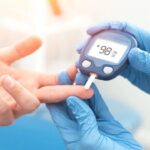The thyroid gland plays a vital role in regulating various organs in the body. To ensure optimal thyroid health, many people wonder about the normal size of the thyroid gland and the parameters reflecting its normal function. Let’s delve into these questions in this article.
1. What is the Normal Size of the Thyroid Gland?

The size of the thyroid gland can vary among individuals
The size of the thyroid gland can vary among individuals and is evaluated through clinical examinations and ultrasound assessments. Here is information on the normal size of the thyroid gland based on these evaluations:
1.1. Clinical Assessment of Normal Thyroid Size
Physicians can palpate the thyroid gland by placing their hands on the front and sides of the neck to assess its size.
The size and consistency of the thyroid gland are evaluated to detect any abnormalities.
1.2. Ultrasound Assessment of Normal Thyroid Size
On ultrasound, the normal size of the thyroid gland is assessed based on the following parameters:
– Length: Typically ranges from 40 – 60mm.
– Width: Usually ranges from 13 – 18mm.
Regarding thyroid volume, the average volume ranges from 10 – 15 ml in females and 12 – 18 ml in males.
It’s important to note that these reference values may vary in different reference materials and may change based on age, gender, and geographical region. Additionally, the status of the thyroid gland may change over time and with the development of thyroid disorders such as Graves’ disease.
To comprehensively assess the thyroid gland’s status, physicians may also perform thyroid Doppler ultrasound to evaluate the blood supply to the thyroid gland and surrounding areas. The velocity of the arteries around the thyroid gland may vary in cases of thyroid disorders such as Graves’ disease.
2. Parameters Reflecting Normal Thyroid Size
2.1. Thyroid-Stimulating Hormone (TSH)
TSH is a crucial parameter for assessing thyroid function. TSH levels are typically measured in the blood, with normal levels ranging from 0.4 – 5 mIU/L. Elevated TSH levels may indicate hypothyroidism, while decreased TSH levels may indicate hyperthyroidism.
2.2. Thyroxine (T4) and Triiodothyronine (T3)
T4 and T3 are the two primary thyroid hormones. Their levels in the blood are also measured to assess thyroid function. Normal T4 levels in adults typically range from 12 – 22 pmol/L, and normal T3 levels range from 1.3 – 3.1 nmol/L. Variations in these parameters may reflect thyroid dysfunction.
2.3. Thyroid Antibody Tests
These tests may be conducted to determine the presence of autoimmune reactions against the thyroid gland. Abnormal thyroid antibodies may be present in thyroid conditions such as Hashimoto’s thyroiditis or Graves’ disease.
2.4. Thyroid Ultrasound
Thyroid ultrasound can be used to examine the size and structure of the thyroid gland. It can help identify abnormalities such as nodules or enlargement of the thyroid gland.
It’s crucial to emphasize that the interpretation of thyroid function tests and diagnostic results should be performed by specialist physicians to accurately assess the thyroid gland’s status and determine the need for treatment or monitoring of thyroid disorders.

Thyroid ultrasound can be used to examine the size and structure of the thyroid gland.
3. Thyroid Disorders
3.1. Hypothyroidism
Treatment typically involves hormone replacement therapy with synthetic thyroid hormone (levothyroxine) to replace deficient thyroid hormone levels. Hormone dosage is adjusted based on blood test results to maintain normal thyroid hormone levels in the blood.
3.2. Hyperthyroidism
Treatment may include the use of antithyroid medications (such as methimazole or propylthiouracil), beta-blockers (such as propranolol) to control symptoms like rapid heart rate, and sometimes surgical removal of the thyroid gland or treatment with radioactive iodine to reduce thyroid activity.
3.3. Goiter
Treatment for goiter depends on its underlying cause. If iodine deficiency is the cause, iodine supplementation may be provided. In cases of large or obstructive goiters, surgery may be necessary to remove the goiter or treatment with radioactive iodine may be administered.
3.4. Thyroid Nodules
Most thyroid nodules are benign and do not require treatment if they are asymptomatic or do not show abnormalities on diagnostic tests. However, malignant thyroid nodules often require surgical removal. Thyroid ultrasound and fine-needle aspiration (FNA) may be used to determine the nature of thyroid nodules.
It’s important to note that the treatment and management of thyroid disorders should be conducted under the guidance and supervision of specialist physicians. The goal of treatment is to ensure hormonal balance in the body, control symptoms, and prevent complications.
4. Diagnosis of Thyroid Disorders
4.1. Medical History and Symptoms
Physicians conduct interviews with patients to gather information about symptoms and medical history. Symptoms such as fatigue, weight gain, rapid heartbeat, thinning hair, dry skin, or others may suggest thyroid issues.
4.2. Physical Examination
Physicians may perform physical examinations by palpating the thyroid gland to assess its size and density. Abnormalities may be detected through this examination.
4.3. Blood Tests
– Thyroid-Stimulating Hormone (TSH): Blood tests are performed to measure TSH levels. Elevated TSH levels may suggest hypothyroidism, while decreased TSH levels may suggest hyperthyroidism.
– Thyroxine (T4) and Triiodothyronine (T3): Blood tests are performed to measure T4 and T3 levels. These results help assess thyroid hormone levels in the body.
– Thyroid Antibody Tests: These tests may be conducted to determine autoimmune reactions against the thyroid gland.

Thyroid-Stimulating Hormone Test
4.4 Thyroid Ultrasound
Thyroid ultrasound helps examine the size and structure of the thyroid gland and identify abnormalities.
4.5 Fine-Needle Aspiration (FNA) Biopsy
If thyroid nodules are present, FNA biopsy may be performed. This procedure involves collecting a cell sample from the nodule for microscopic examination to determine its nature (benign or malignant).
This article has addressed questions about the normal size of the thyroid gland and methods for diagnosing thyroid diseases. Stay tuned for more articles from TCI Thu Cuc Healthcare System to gain knowledge about diseases and protect your health and that of others.








